
What Visual Search Means for Your Brand
3-minute read | Visual search is nothing new in 2018. How often do you type something into Google and click Images rather than News, Videos, or even Shopping? I know I do. We live in an image-driven, visual world. So it makes sense that many brands utilize visual search technologies, mostly retailers, and see success in trying to reach audiences looking for images in their queries. Here’s some history on image search and how a marketing agency can help you harness its power.
Power of Visual Search
Google Image Search began when developers at Google realized people were using the search engine to look specifically for images. Jennifer Lopez wore her provocative green dress to the Grammys in 2001 and the following day, search queries for J. Lo’s dress skyrocketed, showing Google’s team people wanted more than just text. Visual search became the go-to for retail, medical, and identification queries. In fact, according to a 2017 Moz and Jumpshot study, Google Image Search receives 26.79% of all searches. Think about the progression of images in the past decade. Pinterest launched in 2010 and has reached 250 million active monthly users in Oct 2018. Look at Instagram. Also launched in 2010, Instagram is the world’s most popular social app that revolves around sharing images, reaching 1 billion active monthly users in 2018. Snapchat, the social sharing app for static images or video, reached 186 million daily users by third-quarter of 2018. It’s easy to see that we live in a visual world, but how can brands, and the agencies that support them, live in it? Here are a few ideas.
Visual Search Technology
Visual search technology has evolved into phone apps that allow users to move real-world photos into real-life experiences. Pinterest Lens, launched in 2018, has seen success with over 600 million monthly visual searches through its browser-based desktop extension, Lens. With Pinterest Lens, users can take photos of, really, anything and Pinterest generates related products, recipes, or just things they find inspiring. Magic right? Other visual search offerings include Slyce, which uses AI to find products that match user photos, and retail providers like ASOS who are launching their own visual search tools. Google Lens isn’t far behind Pinterest Lens, launching its latest version this May. Pretty soon search may consist of snapping photos to learn more, and even to buy products when we’re ready.
Retail brands should consider putting their marketing dollars into ads on Pinterest, to try to steer the platform’s 600 million visual searches into conversions. Pinterest also means smart advertising spend learning from and testing out Pinterest’s new ad formats. Since the data is showing that users are buying from promoted pin ads, it’s working. By installing the Pinterest widget on site, users can pin brand images to their boards providing further exposure, better ranking, and sales.
Optimized Images
Web images should be highly optimized. With search queries becoming more holistic than ever before, and Google working to find user intent, or the meaning behind the search, images that are poor quality or unoptimized may get passed over entirely. A grainy or irrelevant photo won’t support Google’s goal of relevancy and efficiency for users. Visual search will pick images that are both optimized and contextually relevant to match with search queries. This means all images on the site, even the ones thrown up there for the blogs, must be pretty damn near perfect. What are perfect SEO images? Answer yes to these six image-based questions:
- Do they relate to the textual content?
- Are they small enough to allow for fast rendering, but still large enough they look good?
- Do they use alt text so Google can read them in the backend?
- Do their file names have descriptive names?
- Are they original and not copyrighted? Did you reverse image search them to make sure? Good-quality stock images are sufficient but the Google bots prefer original photos.
Savy Agency | Visual Search
If any of this is overwhelming or exhausts your capabilities, that’s where a digital agency comes in. Savy stays up on the latest in consumer trends and behaviors and implements the newest digital technologies. Your brand will stay ahead with the help of our digital team, whether the search is text-based, image-based, augmented, or even VR or audibly-based. Yes, there is a whole universe of search techniques, and here at Savy, we can help you integrate the ones you need.
Recent Posts
How to Rebrand Your Instagram for Better Engagement and Brand Recognition
Your Instagram presence can act as a beacon for brand recognition and customer engagement. It’s about painting a picture so compelling that your audience cannot help but be drawn to […]
Read MoreFrom Clicks to Conversions: The Science of High-Performing Digital Ads
The journey from interest to purchase is often paved with digital advertisements. However, not all digital ads are crafted equally. While some fade into the background, others command attention and […]
Read MoreBrand Consistency Examples That Will Make You Rethink Your Marketing Strategy
A consistent and strategic brand identity across all platforms is not just beneficial; it’s essential. By exploring real-world brand consistency examples, we uncover the immense power of maintaining a coherent […]
Read More3 Ways to Transform Blogs With SEO and Make Google Love Your Content
As marketers and business owners, our goal is to ensure the blogs we publish confidently stride into the spotlight of Google’s top search results. Achieving this requires great content, but […]
Read More



